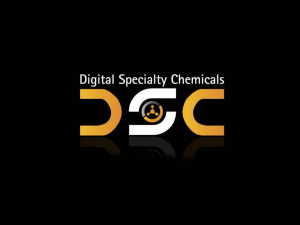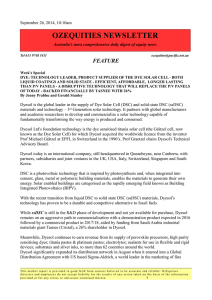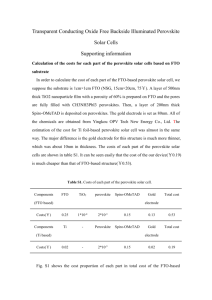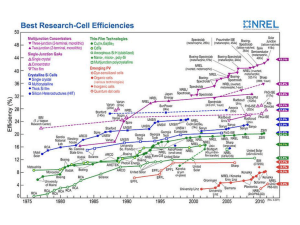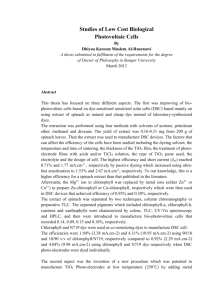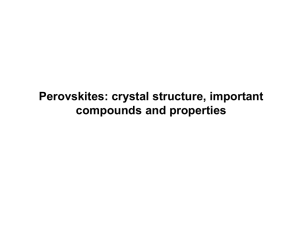Hybrid inorganic-organic photovoltaics, HI-OPV
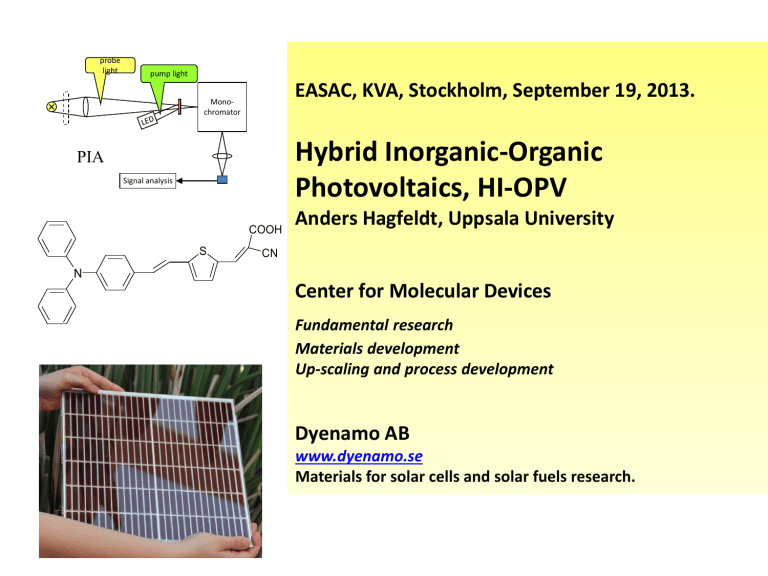
N probe light pump light
PIA
Signal analysis
S
EASAC, KVA, Stockholm, September 19, 2013.
Monochromator
COOH
CN
Hybrid Inorganic-Organic
Photovoltaics, HI-OPV
Anders Hagfeldt, Uppsala University
Center for Molecular Devices
Fundamental research
Materials development
Up-scaling and process development
Dyenamo AB www.dyenamo.se
Materials for solar cells and solar fuels research.
2
Uppsala University
Physical Chemistry:
Anders Hagfeldt
Gerrit Boschloo
Erik Johansson
Leif Häggman
Nick Vlachopoulos
Susanna Eriksson
Marina Freitag
Lei Yang
Yan Hao
Dongqin Bi
Byung-wook Park
Hanna Ellis
Jinbao Zhang
Wenxing Yang
Meysam Pazoki
Kerttu Aitola
Valentina Leandri
Center for Molecular Devices (CMD)
Physics:
Håkan Rensmo
Rebecka Lindblad
Johan Oscarsson
Azhar Zia
Swerea IVF, Mölndal
Henrik Pettersson
Tadeusz Gruszecki
Jan Preisig
Elis Carlström
KTH Stockholm
Organic Chemistry:
Licheng Sun
Yunhua Xu
Martin Karlsson
Erik Gabrielsson
Bo Xu
Haining Tian
Inorganic Chemistry:
Lars Kloo
Gunther Andersson
Mikhail Gorlov
James Gardner
Johnny Slätt
Muthuraaman Bhagavathi
Achari
Viswanathan Elumalai
Majid Safdari
Jiajia Gao
Mesoscopic Dye-sensitized Solar Cells (DSC)
– a versatile and complex molecular system
Brian O’Regan and Michael Grätzel
Nature, 1991, 353, 7377. 7% efficiency.
> 10’000 citations
The paradigm shift by O’Regan and
Grätzel in 1991 meant that we can prepare efficient solar cells without using well-defined and ultrapure
(expensive) semiconductors. Instead we can design molecular and nanostructures and interfaces with optimal electron transfer kinetics and rely on diffusion as charge transport mechanism a lot of chemistry to do!
DSC is a versatile (chemical) device!
Mesoscopic solid-state solar cells
Perovskite solar cells
Water splitting devices
n-type DSC p-type DSC
+
Tandem Cells
Q-dot sensitized solar cells
Some DSC facts
Power conversion efficiency (PCE) laboratory cells: 13.0 % (EPFL), modules: 9.9 % (Sony).
Perovskite solar cells. 14.1% (certified, EPFL), about 15% (EPFL, Oxford)
Outdoor performance - production cost per kWh an advantage for DSC: a 10 % PCE rated DSSC module produces over one year the same amount of electricity as
14-15 % rated Si module (Sony).
Electricity from ambient and indoor light:
DSC outperforms all competitors stability
> 20 years outdoors accelerated testing (Dyesol, Fujikura …) energy pay back time:
< 1 year (3GSolar and ECN life cycle analysis
HANA AKARI
FLOWER LAMP
(SONY)
6
Design: Colours and Transparency
Product Integration
Façade for the new congress hall at EPFL,
Lausanne
Building Integration
How to compete with silicon?
•
Production cost of 50 $/m 2 with 15 % module efficiency gives 0.33
$/W peak
•
Cell efficiencies > 15%?
- Two recent breakthroughs from the DSC community
The hunt for the half volt –replacing the I /I
3
redox couple
Perovskite solar cells
8
Where are the internal losses?
- the hunt for the half volt
e e -
e
Dye-sensitized
Solar Cells
e
e
e
I / I
3
-
TCO
TiO
2
Dye Electrolyte
Can a 2-electron redox couple be replaced by a 1-electron couple?
A problem for almost 20 years
In 2010 we introduced the ’ marriage ’ between a blocking dye and Co-complex redox systems
D35
Feldt, Gibson, Gabrielsson, Sun, Boschloo, Hagfeldt,
J. Am. Chem. Soc. 2010 , 132, 16714.
Best result with Co-mediator without steric groups:
- Electron lifetimes the same for all Co-mediators
- Mass transport best for Co-mediator without steric groups
- Suitable for indoor light
V oc
/ V J sc
/ mAcm -2 FF η / %
[Co(bpy)
3
] n+
1 sun
1/10 sun
250 lux
0.92
0.85
0.7
10.7
1.12
18.5 x 10 -3
0.68
0.76
0.8
6.71
7.15
0.22 M Co-red, 0.033 M Co-ox, 0.1 M LiClO
4 acetonitrile and 0.2 M 4-tert butylpyridine (TBP) in
The World Record DSC is Based on Porphyrine
Dye and Co-complex Redox Electrolyte
Grätzel and co-workers: The SM315 porphyrin reaches a record efficiency of 13% :
Solid-State DSC
DSSC using redox electrolyte DSSC using hole transport material
Redox electrolyte PCE dye
Solid hole conductor PCE light harvester dye or pigment film
TiO
2
TiO
2
Solid-state DSSC
In collaboration with BASF SE and EPFL.
ID176 spiro-OMeTAD
Cappel et al.
J. Phys. Chem.
C , 2009 , 113 , 14595
ID176 + spiro-OMeTAD
Works well for ssDSSC (> 3%), but very poor in liq-DSSC (<1%)
Why does ID176 work in solid and not in liquid DSC?
CB
B.
Injection in surface states?
3
Reduced Dye
Excited state
A.
Ultrafast regeneration of the oxidized dye.
1
Spiro-OMeTAD
2 ps regeneration
Reductive quenching mechanism.
Cappel et al. JPC C, 2011, 115, 4345
Reductive quenching may allow for electron conduction through a dye/ETA layer
*ETA = Extremely Thin Absorber
-
-
-
-
+
Dye/ETA layer
Ultrafast regeneration by solid-state hole conductor
Perovskite Solar Cells - An Organic-Inorganic Hybrid
18
Cross sectional SEM of a mesoscopic p-i-n solar cell with
TiO2/perovskite as light harvester nanocomposite n i
P
Certified record efficiency of 14.1% by Grätzel and coworkers.
20
Our latest perovskite results from CMD
RSC Adv., 2013, DOI: 10.1039/C3RA43228A
Best efficiency, 10.8%, obtained with ZrO
2 as scaffold.
Several open fundamental questions
• Perovskites work on insulating substrates like ZrO
2 electron injection necessary?
and Al
2
O
3
. Is
• Works without the p-type hole conductor (direct contact between
Au and perovskite).
• Low exciton binding energy (30 – 50 mV). Selective contact device?
• Reproducibility (morphology of perovskite vs preparation conditions)
• Stability: for a single crystal perovskite there is e.g. A phase transtion at 55 0 C (from tetragonal to cubic)
• Possibilities to replace Pb?
• Opens up 3rd Generation concepts?
The possibilities for efficiencies >15%
Cf. O ’ Regan et al . Chem. Mater.
23 (2011) 3381
- 0.6
- 0.35
0.25 eV
- Absorber with band gap of
1.6 eV (ca. 800 nm)
- 0.25V for driving force for injection and regeneration
0.75
1.0
1.6 eV
0.25 eV
- Possible efficiency:
- V oc
=1.1V, J sc
= 22 mA/cm 2 ,
FF = 0.73.
- PCE= 17.66 %
V vs NHE
Cf. Grätzel et al. Nature Comm.
•
Module efficiencies of 15%
3 (2012) Art. Nr. 631 possible
Financial Support - CMD
Knut & Alice Wallenberg
Foundation
Sony Deutschland GmbH
Merck, Germany



